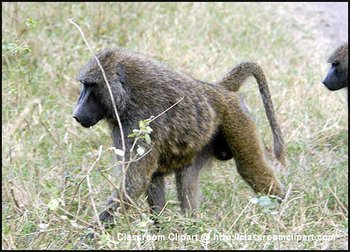Baboon
|
|
| Baboons | ||||||||||||
|---|---|---|---|---|---|---|---|---|---|---|---|---|
 Olive Baboon (Papio anubis) | ||||||||||||
| Scientific classification | ||||||||||||
|
The Baboon is the largest non-hominid member of the primate order. The English word Baboon is thought to derive from that of the Egyptian baboon-god Babi.
All baboons have long dog-like muzzles , close-set eyes, heavy powerful jaws, thick fur except on their muzzle, short tail and often brightly coloured ischial callosities. Baboons are terrestrial (ground dwelling) and are found in savanna, open woodland and hills across Africa. Their diet is omnivorous, but usually vegetarian - they are foragers and are active at irregular times throughout the day and night. They can raid human dwellings and in South Africa they have been known to prey on sheep and goats.
Baboons live in hierarchical troops of 5 to 250 animals (50 or so is common), depending on species and time of year. They can live as long as thirty years.
Their principal predators are man and the leopard, although they are tough prey for a leopard and large males will often confront them.
There are five recognised species of Papio, although there is some disagreement about whether they are really full species or subspecies. They are P. ursinus (Chacma Baboon, found in southern Africa), P. papio (Guinea Baboon, found in Senegal, The Gambia, Guinea), P. hamadryas (Hamadryas Baboon, found in north-east Africa and into south-western Arabia), P. anubis (Olive Baboon, found in central African savanna) and P. cynocephalus (Yellow Baboon), found in Angola, Zambia, Malawi, Tanzania, Kenya, Somalia). Many authors distinguish P. hamadryas as a full species, but regard all the others as subspecies of P. papio and refer to them collectively as "savanna baboons"; even between Hamadryas Baboons and the neighbouring savanna populations there is a stable zone of hybridisation.
There is considerable variation in size and weigh depending on species, the Chacma Baboon can be 120 cm and weigh 40 kg while the biggest Guinea Baboon is 50 cm and weighs only 14 kg, in all baboon species there is pronounced sexual dimorphism usually in size but also sometimes in colour or canine development.
The Hamadryas Baboon was a sacred animal to the ancient Egyptians as the attendant of Thoth, and so, is also called the Sacred Baboon.
| Contents |
Reproduction
Baboon mating behavior varies greatly depending on the social structure. In mixed groups, each male can mate with any female. The allowed mating order among the males depends partially on the ranking and fights between males is not unusual. There are however also subtler possibilities; some males try to win the "friendship" of some females. To garner this friendship, they may help groom the female, help care for her young, or supply them with food. Some females actually prefer such "friendly" males as mates. Females initiate mating by presenting her swollen rump to the male. In harems, the males are jealous guard their females, to the point of grabbing and biting them if they even approach other males. It comes nevertheless occasionally to the "foreign going", for example if unmarried males follow after partner interior search of a group. At such opportunities it often comes to aggressive fights under the males, yet some succeed in again and again making for others a female estranged.
Usually every other year, and after an approximately six month gestation, the female gives birth to a single young. The young baboon weighs approximately a kilogram and is colored black. The female tend to be the primary caretaker of the young, although several females will share the duties for all of their offspring. In mixed groups males sometimes help in caring for the young of the females they are "friendly" with, and the probability is high that they are their offspring; for instance they gather food for them and play with them. After scarcely one year the young animals are waened and to reach the sexual maturity in five to eight years. If they leave their birth group, and nearly all animals from harems and males from mixed groups do, then usually this is before they reach maturity.
Baboons in captivity have been known to live up to 45 years in captivity, while in the wild their life expectancy is about 30 years.
Species list
Genus Papio
- Hamadryas Baboon or Sacred Baboon, Papio hamadryas
- Guinea Baboon, Papio papio
- Olive Baboon, Papio anubis
- Yellow Baboon, Papio cynocephalus
- Chacma Baboon, Papio ursinus
See also
Pictures of Animals
- Baboon Pictures (http://classroomclipart.com/clipart/Animals/Baboon.htm)
- Pictures of Animals (http://classroomclipart.com/clipart/Animals.htm)
Animal Clipart
- Animal Clipart (http://classroomclipart.com/clipart/Clipart/Animals.htm)


